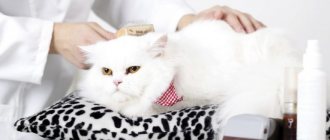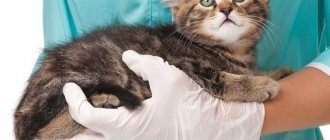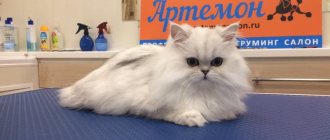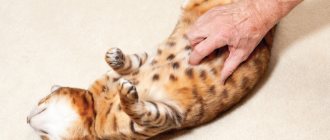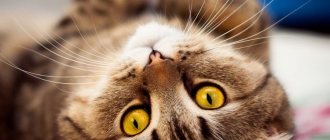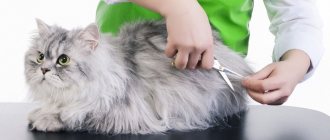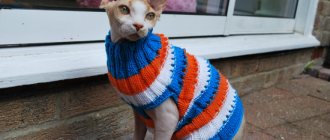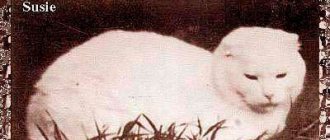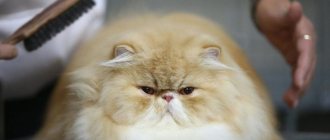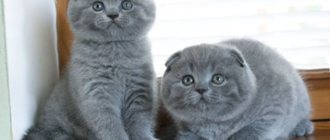After grooming, the Scottish cat needs to be washed again with shampoo. This will remove cut hairs and wash out the bottom layer of fur that may not have been completely cleaned during the first bath.
Grooming a cat is a rather labor-intensive and complex process, since most pets do not tolerate such procedures well. Therefore, unless absolutely necessary, you should not subject the animal to such a test. And if the owner is not confident in his skills, then it is better to seek help from professionals.
Do Scottish Fold cats need to be cut?
Grooming a Scottish cat is not the most popular procedure; most often the hair is shortened as needed, for example, before medical procedures or if the pet is very dirty. Some owners prefer to groom their cats before shows and for photo shoots.
Important! If a Scot is getting his hair cut for the first time, then it should be done by a specialist. Then the cat will receive minimal psychological stress, and the owner will become familiar with the procedure and will be able to repeat them on his own in the future.
Reasons for haircut
The most common reasons that prompt an owner to cut a Scottish cat's hair are:
- Formation of tangles and unkempt appearance of the coat. This applies to long-haired Highland Folds that are poorly groomed.
- Excessive and prolonged shedding - during this period, Scottish cats are cut to get rid of excessive amounts of hair on carpets and sofas.
- Skin diseases. More often they arise due to poor care of the Scots, but sometimes they also appear for reasons beyond the control of the owners.
- Formation of hairballs in the stomach (trichobezoars).
The thick undercoat forms a dense “felt” layer, does not allow air to pass through and creates comfortable conditions for the proliferation of skin parasites. Unlike tangles, which you can try to comb out, here cutting is the only rational solution.
Is it necessary to cut a handsome man's hair?
Cats' fur is not only decoration, but also the main source of heat transfer. Having lost its fur, the cat will freeze even in summer. A fatty lubricant is formed under the fur, which protects the skin from drying out. Some pets experience discomfort after a haircut and even often become depressed. Therefore, you should resort to grooming in case of emergency.
The main indication for a haircut is the presence of tangles. Their formation can provoke such unpleasant situations:
- The matted fur pulls on your pet's skin. This leads to pain and nervousness.
- On the skin where there are tangles, blood flow and heat exchange are disrupted, inflammation begins, accompanied by itching and peeling.
- When licking, the fur enters the gastrointestinal tract. Having huddled together, she disrupts his work.
- The animal may try to gnaw out the mat on its own and cause serious wounds to itself.
If the Scottish Fold cat is old, he will not be able to take good care of his coat. Therefore, tangles appear much more often, therefore, they need to be trimmed. Hair often gets matted in the armpits, under the hind legs, on the neck, behind the ears and on the tail. If the lumps are insignificant, then they can be combed out or carefully cut off without resorting to cutting the entire body.
Often the reason for a change in image is the seasonal change of coat.
There are a number of other reasons for grooming a Scottish cat:
- skin diseases;
- application of medications;
- molting;
- the owner has an allergic reaction to cat hair.
How to cut your hair at home
Tools and accessories
You can only trim a very calm cat at home, and if it is already accustomed to such a procedure. The easiest option is to trim the fur with a machine with one attachment. Every owner should have the simplest skills necessary for grooming a pet. In hot weather, a short hairstyle can save your long-haired pet from heatstroke.
You will find most of the cutting equipment at home. The procedure can be done on a table, covered with a sheet, or on an ironing board. In the latter case, the “stand” must be stable. Scissors - simple and thinning - will also come in handy. Hair clippers are also often found in homes. If not, you can purchase it at the store. It should be comfortable and have various attachments. You cannot do without it when performing the procedure. Also purchase three percent hydrogen peroxide and cotton wool. Your pet should also have a comb-comb.
A minimum of two people will be needed to perform the procedure. It is better if the helpers know how to handle cats.
Appearance of the Scottish Straight
Scottish Straights can easily be confused with the British, although representatives of these two breeds have a minimum of common genes. Scottish Straight cats are much smaller than their competitors from Albion, although they have a longer body. The weight of an average straight is 3-3.5 kg. Modern breeders are still wondering what kind of offspring they will get after mating a fold and a straight, since initially all kittens are born with ordinary ears, which change their position only at the end of the first month of life.
Head
Mustachioed Scotsman
According to the WCF standard, Scottish Straights must have a rounded skull. Representatives of this breed have convex foreheads and cheeks. In cats, the area of the cheekbones and cheeks is noticeably more rounded than in cats. The chin of the Scots is firm, rounded, but does not protrude forward. The whisker pads are distinguished by their characteristic “swelling” and have the shape of a regular oval.
Nose
Wide and short, with a slight arch of the back and a pronounced base, practically without a stop.
Eyes
Large and round, widely spaced. The gaze is open, inquisitively focused. Eye color depends on the coat color of the animal.
Ears
Erect, small, with a wide base. The tips of the ears are rounded and point forward. The outer part of the ear is covered with thick, close-fitting hair. The inner part is decorated with lush and stiff hair brushes extending beyond the edge of the ear.
Neck
The Scottish Straight cat has a muscular and short neck.
Scottish Straight muzzle
Frame
Moderately long, muscular and wide, tending to the rectangular type. The silhouette line is soft and rounded.
Limbs
Proportional to the body, that is, moderately long and strong, with developed muscles. The paws are oval, the toes are tightly clenched.
Tail
Medium or long, mobile, reaching to the middle of the shoulder blades.
Wool
Scottish Straight tabby color
Short or semi-long (in Highland individuals). Double, plush type, with well-developed undercoat. It does not adhere to the body, but covers it tightly. The texture of the coat may vary slightly depending on the season, as well as the type of color of the animal.
Color
The standard allows all types of colors found among representatives of this breed. The most typical color options for Scottish Straight cats are solid, bicolor, point, tabby, particolor, chinchilla, ticked, van and shedded.
Defects in appearance and disqualifying defects
Individuals with semi-erect or too wide ears with a British set are considered not the most successful representatives of their breed. The flat forehead, pronounced stop, long legs and small eyes of the Scottish Straight are also not decorative. Animals with an insufficiently long, inactive and kinked tail, cryptorchidism and everted toes are subject to unconditional disqualification. Weak and sick cats are also not allowed to participate in exhibition events.
Kittens from a Scottish Fold cat, with an average of five straight-eared and one fold-eared
What harm can a haircut cause?
The negative consequences of grooming in Scottish cats include both physiological and psychological factors:
- If there are other cats in the house, the short-haired Scottish Fold will most likely lose authority in the family hierarchy of four-legged pets. He will have to re-prove his right to a “place in the sun.”
- It has been noticed that after a haircut, which is a serious psychological stress, pampered lop-eared Scots very slowly return to normal.
- Damage to the whiskers during the cutting process. Sensitive hairs grow throughout the cat's body and help her navigate in space. Therefore, after the procedure, the animal may sway slightly when moving, but this quickly passes.
- Skin deprived of hair becomes chapped, peels and dries out. Additional care will be required to keep your Scots skin healthy until the new coat begins to protect it from the elements.
- It will take time for the fur to recover after shearing. The fact is that under natural conditions, hair does not change simultaneously, but is renewed gradually. Mechanical hair removal disrupts this process. Therefore, the new coat will be slightly worse than the previous one.
Most often, Scottish cats are cut on the recommendation of a veterinarian.
The dangers of haircuts
A trimmed Maine Coon loses important qualities:
- Heat exchange and touch are disrupted.
- The structure of the coat changes - it becomes fluffy and soft, similar to the wool of a Persian.
- The psyche is disturbed, the animal experiences stress and may hide.
- The guard hair does not grow back for a long time.
Everyone knows that a cat's whiskers play an important sense of touch and will never be trimmed. But few people know that there are tactile points on wool too. Without them, the cat begins to perceive what is happening around differently, its behavior changes. A Maine Coon feels really stressed after a haircut.
Shaving, especially with a clipper, slows down hair growth. Plus, it changes its structure, becomes thin, fluffy and can begin to curl. In veterinary medicine there is a term “follicular arrest” - this is when, after cutting, the follicles go into hibernation and take a very long time to recover. In Maine Coons, as they have a thick undercoat, this type of alopecia is also possible. And if in young animals the coat is restored within 3-4 months, then in older coons the process is long.
Types of haircuts
There are different ways to cut a Scottish cat's hair. However, two models have already become traditional for all cats:
- Haircut “like a lion” - the head and mane to the shoulder blades, paws and the tassel at the tip of the tail remain untouched.
- “Puss in Boots” haircut – from the neck the body is machined, at the end of the legs neat boots of arbitrary height are made and a tassel is always left on the tail.
- “Like a dinosaur” - the head and paws of a Scottish cat are cut “like a lion”, but a jagged ridge of wool is formed along the spine.
- Cat in a skirt - haircut for girls. A fluffy hem is left on the body just below the line where the ribs end, and the rest of the hair is shaved.
This is interesting! Recently, a new fashion trend has emerged - applying colored patterns to wool. You need to use only high-quality paints that are safe for your pet’s health.
Model fur processing
To create a beautiful hairstyle, a model haircut is used. It is produced using hairdressing and thinning scissors and various combs. Nozzle No. 3 is usually put on the machine.
It is necessary to consider some interesting cat hairstyles that are currently the most popular. Grooming cats requires a great deal of imagination and artistic taste. They can create such a creative image as a lion or a dragon.
For example, how to cut a cat like a lion: the hair is left at the tip of the tail and around the head, creating a lion's mane.
Such model cat haircuts serve both hygiene and image.
Dragon hairstyle:
- The fur remains only on the head, paws and tail.
- A strip is left along the top of the entire length of the back, along which triangles are then cut, reminiscent of the appearance of dragon teeth.
- The tail is decorated with the same triangles. Thus, the cat becomes like a little dragon.
Sometimes different designs are created on the back or sides in the form of letters, circles, triangles, squares, etc. You can do all this yourself, in a beauty salon, or call a specialist to your home.
Before the event, you need to stock up on hydrogen peroxide or iodine. An assistant holds the paws. Start from the back, then moving to the sides. The paws can be trimmed with scissors. Work very carefully on the abdomen and intimate area. If your cat behaves strangely for a few days after the haircut, you should contact your veterinarian.
How shelters for cats and dogs work in Moscow
Why groom cats?
Typically, cats are clipped for two reasons. The first is to take care of the pet’s health, and the second is to add attractiveness. Regarding health status, there are medical indications for grooming:
- skin diseases;
- infestation with ticks and fleas;
- hyperplasia.
In all these cases, the skin should be treated with medications and haircuts cannot be avoided. Also, with age, it is difficult for elderly pets to keep their fur coat in good condition, so by trimming the fur, the owner makes it easier for himself to care for his pet.
There are also cases when an animal was picked up on the street, and the cat looks unsightly: tangled fur, pellets and “icicles.” The only way to help your pet and bring it back to normal is to trim its fur. But it will be difficult to manage on your own.
Scissors should not be allowed in as they can damage the skin. It is also unlikely that you will be able to comb matted fur. Bathing is problematic, since tangles take a long time to dry and can lead to inflammation. The only way out is to shave your pet and continue to provide careful care. You should shave with a clipper carefully, holding the skin so as not to injure the little one.
Creative haircut
There are no clear rules here. Everything is limited by the imagination of the owner or groomer. You can create any pattern from wool: make waves, stripes, twisted lines. Moreover, the patterns can be on the body or tail or everywhere at once.
The groomer can offer to cut any shape: bow, stars, etc.
Before you decide on such a haircut, think about whether you really need it. The animal doesn't really need patterns. Shortening the length will be enough for him. It often happens that creative grooming disfigures the appearance, you will have to get used to the strange appearance of your pet.
How often can you groom an animal?
The regularity of haircuts depends on 2 factors: the cat’s reaction and possible consequences for its health. If the first haircut provoked long-term stress or lowered the status of the animal among other four-legged animals, then in the future it is worth abandoning such procedures.
You also need to pay attention to how the haircut affected the structure and color of the coat.
Before grooming your pet, it is advisable to seek advice from a professional groomer or veterinarian.
Important! Shorthaired Scottish Fold Fold cats are groomed no more than once a year. Longhaired Highlands will take even longer to fully recover from the first treatment.
How to accustom a Scottish Fold to hygiene procedures?
Scottish Folds are not very fond of swimming, so it may take you a lot of time to accustom your pet to water. It is best to start from childhood. While washing, try to calm the cat with gentle words. If she's not in the mood, don't torture her. Better put off bathing until next time.
If the animal is afraid of a comb, use a massage mitten for combing. In this case, the cat will think that you are stroking it and it will not resist.
If you want your pet’s coat to be beautiful and healthy, use a special shampoo for short-haired cats – “Royal-Groom”. The product contains no harmful substances, it perfectly moisturizes the coat and makes it shiny.
Why do you need a cat grooming?
The main purpose of grooming is to take care of the condition of the cat's coat. It is in the nature of the cat breed to take care of its fur. But often the efforts of pets alone are not enough, this is especially true for cats whose fur exceeds 3 cm. Those with long coats are recommended additional care, which includes daily combing, removing tangles, and cutting off excess hair.
There are two types of zoo clipping:
- Hygienic.
- Model (exhibition).
What owners should know
Model or hygienic grooming of cats is a safe and useful procedure, but there are cautions and contraindications for its implementation. It is best for owners to be aware of the possible adverse effects before trimming their pet. Many owners follow fashion trends without thinking about how their four-legged friend will react to all sorts of innovations.
- Visiting a grooming salon and contact with strangers is a huge stress for a cat. If there is no urgent need due to current molting, urgent preparation for an exhibition, the presence of a large number of tangles, or treatment of skin pathologies, then it is better to refrain from testing the pet’s nerves. Depending on the animal's temperament, groomers may use a partner to restrain the animal or administer sedation.
- There is no need to overestimate your abilities and try to remove fur from the skin of your furry four-legged friend yourself. It must be borne in mind that household scissors and clippers for cutting human hair are not suitable for such purposes. In any case, this cannot be done without outside help due to the fact that most animals are reluctant to allow their fur to be manipulated. The most harmless thing that can happen if domestic cats are groomed in an artisanal way is a spoiled appearance. But the worst thing is that you can injure the animal or get severe scratches from it.
- If your four-legged pet is not a sociable member of the cat family, so as not to have to use anesthesia, it is better to trim the cat at home using the service of a groomer. In a home environment, the cat feels in its territory and its behavior will be calmer.
- Long-haired cats should be groomed 2 or 3 times a year. The frequency of hairdressing procedures depends on the initial length, intensity of hair growth, and the health status of the pet.
- A few days before the hairdressing procedures, the cat will need to shorten its claws to prevent injury to the master, his assistants and the animal itself.
- It is strictly forbidden to cut the hair on the cat's head, shorten the mustache, eyebrows, or hairs in the ears. The tail must also be treated with extreme care; long hairs can be cut off from this area, but completely shaving off the fur is not recommended.
- It is necessary to take into account the fact that in some cats, after hairdressing manipulations, the fur changes its structure, the hairs become thinner or thicker or change color.
- From practice, there are cases when the fur of cats grows back to its original length over a long period of time or completely stops growing.
This is interesting: Where can you go without a visa?
Why do you need to groom your pets?
There are many situations in which grooming cats is acceptable, if not vital. And we’re not just talking about going to a felinological competition. Very often, veterinarians advise resorting to grooming when they notice a problem with the animal’s fur or skin.
In this regard, all types of haircuts for cats can be divided into two categories:
- Model.
- Hygienic.
Model grooming is performed mainly for exhibitions and is a real work of art.
A completely different matter is cutting the fur, which is necessary to maintain the health of the pet. Hygienic cat grooming has a more familiar look and is easy to perform:
- Most often, it is done to avoid matting of long hair or to remove formed tangles that cause pain to the cat.
- Cats actively lick themselves and can either injure themselves trying to gnaw out the mat, or eat a lot of hair, which rolls into lumps in the stomach and can cause intestinal obstruction.
- The veterinarian may prescribe a haircut in case of skin diseases or parasites.
- Some animals have a problem such as feces sticking to the long hair near the hind legs and tail. In this case, you don’t have to cut the whole animal, but just shorten the “pants” a little.
- Many cats with long or semi-long hair undergo grooming in the summer heat to protect them from overheating. This is especially necessary for Siberian cats, Persian cats, Norwegian forest cats and others accustomed to colder climates.
- It also happens that an old or sick animal cannot care for its fur on its own. In this case, a haircut helps him stay clean and look decent.
Model haircut "Dragon"
Model cat grooming can be done not only for a trip to an exhibition. Many owners regularly visit the salon to give their pet an original look. Each hairstyle is individual. And yet, there are several of the most popular varieties, on the basis of which groomers create their exclusive works of hairdressing art.
- "French Lion" For this hairstyle, the back, top of the paws and base of the tail are completely trimmed. The head and neck fur remain intact, giving the impression of a luxurious mane. The tip of the tail is not cut either. A specialist can give it the shape of a lion tassel, a pompom, a stepped herringbone or a neat whisk. Sometimes the fur is shortened just a little, resulting in a fluffy squirrel tail. The length of the “socks” and “gloves” on the paws can also vary. Thus, a unique image of the animal is created.
- "Puma." This haircut is done in almost the same way as the “Lion” option, but in addition the fluffy shirtfront on the chest is preserved.
- For the “Dragon” model, the sides and belly are cut smooth, while the hair along the ridge and tail remains untouched. It is only given the shape of a carved comb with sharp teeth.
- “Puss in Boots” fully corresponds to its name: the fur on the animal’s back is shortened, and the upper part of its paws is cut off to make neat boots.
There are also more intricate haircuts - such as “Modern”, “Continental”, “Harlequin”. All of them are performed only by specialists.
Model haircut "Puss in Boots"
The question of whether to contact a specialized office or trim the pet’s fur themselves arises among owners very often. There are quite a lot of arguments in favor of both options. Grooming cats at home is much cheaper, and many mustachioed purrs perceive trips to the salon as very stressful.
The difficulty is that not all animals tolerate grooming calmly. Some people so actively resist attempts to cut their hair that they have to be sedated. Most often, mild muscle relaxants are used in this capacity: these medications do not completely immobilize the cat, but reduce activity and make all its reactions more inhibited. Only a professional can choose the right medicine, give the correct injection and monitor the condition of the four-legged patient.
Even choosing a shampoo for bathing before a haircut sometimes turns into a difficult task. An incorrectly selected grooming product can damage the coat, cause allergies or skin irritation, and in the worst case scenario, even cause the animal to go bald.
Additionally, cat grooming varies greatly in difficulty. Hygienic or the simplest of model haircuts, such as “lion”, “puma” or “puss in boots”, can be easily done at home. Others, more complex ones, can only be done by a specialist. Thus, it is often much easier to pay for a trip to a clinic or salon. Usually a groomer gives a cat a haircut in an equipped office, however, a home call is quite possible.
Animal clipper
If you still decide not to go to the salon, then keep in mind: grooming cats is not the easiest task. You will need a lot of patience and some tools:
- Hair clipper.
- The attachments for it are at least 3 mm long (it is best to use veterinary attachments No. 3 for these purposes).
- Comb-comb.
- Regular or hairdressing scissors (if you want a “designer” hairstyle, you can take both regular and filer scissors).
- A high table or ironing board at which you can work comfortably.
- Just in case, prepare hydrogen peroxide and cotton wool.
And, of course, you need to take into account that for such a procedure you will need an assistant, or better yet two. After all, most animals perceive attempts to cut their hair very aggressively, and someone will have to hold the wayward cat so that she does not injure her “hairdresser.”
Place your pet on the tabletop, holding him by the front and back legs so that he cannot twitch. Carefully trim the fur first on the back, then on the belly, paws and tail. If necessary, trim any stray hairs.
After completing the procedure, be sure to bathe the animal to wash off any remaining hair on its skin.
Professional groomer kit
If you have dreamed of getting yourself a lion since childhood, but there was no opportunity, then this video will show you how to transform...
Technique of the procedure
Before grooming Scottish Folds, it is recommended to trim their nails. You can also use thick wristbands to protect your wrists from scratches.
The procedure is carried out in several stages:
- Apply a degreasing composition to dry wool and rub it well along the entire length of the hair. In longhaired Scots, special attention is paid to the tail, hind legs and collar area. To the rest of the body (including the head), the drug is usually applied without much effort.
- After the period of time specified by the manufacturer, the product is washed off with water.
- Apply the main shampoo, rub it with your hand until foam forms and after 2-3 minutes rinse thoroughly. The procedure can be repeated several times (depending on the degree of contamination of the wool).
- The final stage is treatment with conditioner, which gives the wool shine, silkiness and covers it with a protective layer.
- After bathing, the Scottish cat is wrapped in a towel and the coat is dried.
- The haircut is performed using a special electric clipper, but in the groin area and under the tail, the hair is carefully removed with ordinary scissors.
- Scissors are also used to form curly elements of the hairstyle and trim.
After grooming, the Scottish cat needs to be washed again with shampoo. This will remove cut hairs and wash out the bottom layer of fur that may not have been completely cleaned during the first bath.
Grooming a cat is a rather labor-intensive and complex process, since most pets do not tolerate such procedures well. Therefore, unless absolutely necessary, you should not subject the animal to such a test. And if the owner is not confident in his skills, then it is better to seek help from professionals.
History of the Scottish Straight cat breed
Scottish Straight cat
Scottish Straight are the same Scottish folds, but with a modified position of the ear. Straight ears do not have a characteristic crease and are set straight, and this, in fact, is the only external sign that distinguishes them from their fold-eared counterparts. Scottish cats are considered one of the youngest cat breeds. The first cat with an unusual, flattened ear shape appeared on a Scottish farm in the early 60s. Surprisingly, the ancestor of modern folds and straights had no pedigree and simply chased mice through the barns of local peasants.
The first official Scottish breeder was an ordinary villager, William Ross, who adopted a kitten from the aforementioned Fold. A few years later, professional breeders also joined the process. At the same time, experts witnessed an interesting phenomenon: in the litters brought by even the most purebred Scottish dogs, babies with erect ears appeared. Of course, no one intended to separate such individuals into a separate breed. And kilometer-long queues did not line up for straight-eared kittens, because against the backdrop of touching folds, they were outright losing. But here nature itself intervened.
Very soon, Scottish breeders noticed that attempts to strengthen and strengthen the lop ears of animals had a negative impact on their health. The mutated gene responsible for the flatness of the ear folds began to inhibit the function of the skeletal apparatus of cats. As a result, the Scots began to suffer from thickening of the bones and osteochondrodysplasia. To keep the breed afloat, breeders rushed to look for “new blood” that would help the Scottish survive and reduce the number of their genetic defects. Through trial, error and outcrossing, it was discovered that the healthiest and most beautiful offspring can be obtained from crossing a Fold cat and a straight-eared male of the same breed. It was thanks to this discovery that breeders and felinological associations finally turned their attention to straight-eared Scots. Well, in 2004, the Scottish Straight subspecies received official recognition from the World Cat Federation and the status of an independent breed, which sharply increased the attractiveness of straight-eared cats in the eyes of potential buyers.
